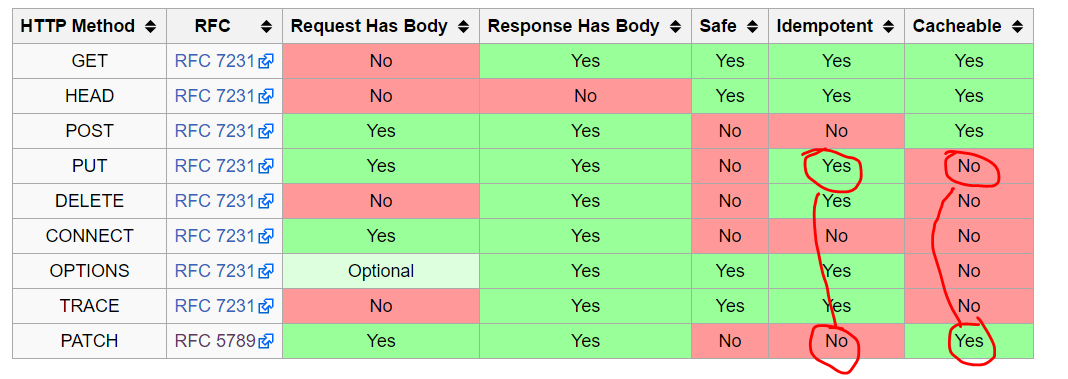PATCH vs PUT and the PATCH JSON syntax war
ArticleThere are several articles/discussions on parallels of PUT vs PATCH and when to use one before other. Also the main struggle recent years seems to be how to translate the RFC proposal for PATCH JSON format. I’ve decided to spam the internet with one more opinionated article on this topic trying to explain everything one more time.
First of all I’m a Ruby on Rails developer so I will reference some sources from RoR world, but everything I say in this article apply to any programming language / web-app framework. So please read the entire article before you start judging
:)

Probably best summarization of the difference I’ve ever seen is this comment from Rails PATCH Pull Request proposal:
PATCH and PUT have different semantics. PUT means create/replace and it is idempotent. PATCH means update (full or partial) and it is not idempotent. (source, author: @fxn)
So what does this mean?
I will borrow definition of Idempotency from www.restapitutorial.com:
You own a cow, you want to have more cows. So you hire sire service to impregnate your cow. Now that the cow is pregnant, you want even more cows. Should you re-hire sire service to re-impregnate your already pregnant cow even more ?
Can your cow get more pregnant ? Well, no! Cow impregnation is “Idempotent”.
When it comes to REST API:
- PUT is Idempotent
- GET is Idempotent
- POST is non-idempotent
- PATCH is non-idempotent

Idempotency table from https://en.wikipedia.org/wiki/Hypertext_Transfer_Protocol (special thanks to Matt for pointing it out
;))
Funky stuff! Does that mean that with PATCH we can get multiple resources ?
Short answer: no, long answer: first we need to understand the RFC behind PATCH.
Probably the most known article explaining PATCH is article Please do not PATCH like an idiot
As described there the “correct” way how to PATCH User’s email is to send something like this:
# PATCH /users/123
[
{ "op": "replace", "path": "/email", "value": "[email protected]" }
]
I’ve also seen a version like this:
# PATCH /users/123
{ "change": "email", "from": "[email protected]", "to": "[email protected]" }
Quote from the article:
You can use whatever format you want as “description of changes”, as far as its semantics is well-defined.
…resulted to really interesting discussion and I’m recommending everyone to read it.
The bottom point is that if you send one request changing User email from “A” to “B”, and at the same time you request change from “A” to “C” second requests should fail! And this way your PATCH it is non-idempotent.
# request_sent_at | from | to | response
# 2016-12-11 23:43:02 | [email protected] | [email protected] | 200/204(Success)
# 2016-12-11 23:43:03 | [email protected] | [email protected] | 422 (Unprocessable Entity)
# 2016-12-11 23:43:04 | [email protected] | [email protected] | 200/204(Success)
Error handling status codes are defined here: https://tools.ietf.org/html/rfc5789
Therefore the article “Please do not PATCH like an idiot” is suggesting that this way of PATCHing is incorrect:
# PATCH /users/123
{ "email": "[email protected]" }
# ..or
{"user":{ "email": "[email protected]" }}
This is due to the fact that you are not describing a change therefore if you trigger them at the same time you would just say “change User email to B”, “change User email to C” and nothing would stop the second change. Therefore this way your PATCH is technically idempotent.
# request_sent_at | to | response
# 2016-12-11 23:43:02 | [email protected] | 200/204(Success)
# 2016-12-11 23:43:03 | [email protected] | 200/204(Success)
# 2016-12-11 23:43:04 | [email protected] | 200/204(Success)
Ruby on Rails developers are very well known to this format.
Does it mean that we all are doing it wrong ?
Should we use PUT instead ?
Well, no! …or maybe if it fits the definition.
PUT can be used not only for updating resources, but also for creating resources too. Good example is AWS S3 API. There you will use PUT to add the document to your bucket, and it still properly RESTful !
I would even argue that PUT has nothing to do with “update” at all, but it represent “replace”.
To truly comply witch RFC when you want to update user email with PUT you would have to send all resource attributes (username, password, address …), not only the email (as you are “replacing” the resource with a new one)
So with PUT you are replacing or creating resource. PATCH is for update.
Both release notes for PATCH in Ruby on Rails 4 and Original PATCH proposal Pull Request doesn’t discuss the changeset
from -> toscenario. They are mainly discussing that PATCH represent the update action more than PUT.
Conclusion
So that doesn’t solve the fact that some developer will say that this
{"user":{ "email": "[email protected]" }} PATCH style is wrong.
My opinion is that this is not really a problem. Lets be pragmatic, most of the time your applications don’t deal with such large number of request that suddenly every endpoint would be updated at the same time.
When this day comes and you actually have this kind of scenario on some endpoints you can pass & store version number of a last request. So for example both requests will send header with same “version” but along with the email change we would store the version number (e.g. in Redis) and therefore second request would still point to the old version, therefore this request would be non-idempotent even with that JSON syntax.
# PATCH /users/123
{"user":{ "email": "[email protected]" }, "version":"v1" }
# request_sent_at | version | to | response
# 2016-12-11 23:43:02 | v1 | [email protected] | 200/204(Success)
# 2016-12-11 23:43:03 | v1 | [email protected] | 422 (Unprocessable Entity)
# 2016-12-11 23:43:04 | v2 | [email protected] | 200/204(Success)
Now this solution technically still doesn’t comply with PATCH RFC but like I said, check the arguments in the Don’t PATCH like an idiot discussion
In the end it’s the end product and the team that realy matters, not killing yourself over every rule.
Technically you are doing same level of RFC heresy when you do PUT without passing all resource aruments as when you are PATCHing without changeset.
Entire blog website and all the articles can be forked from this Github Repo